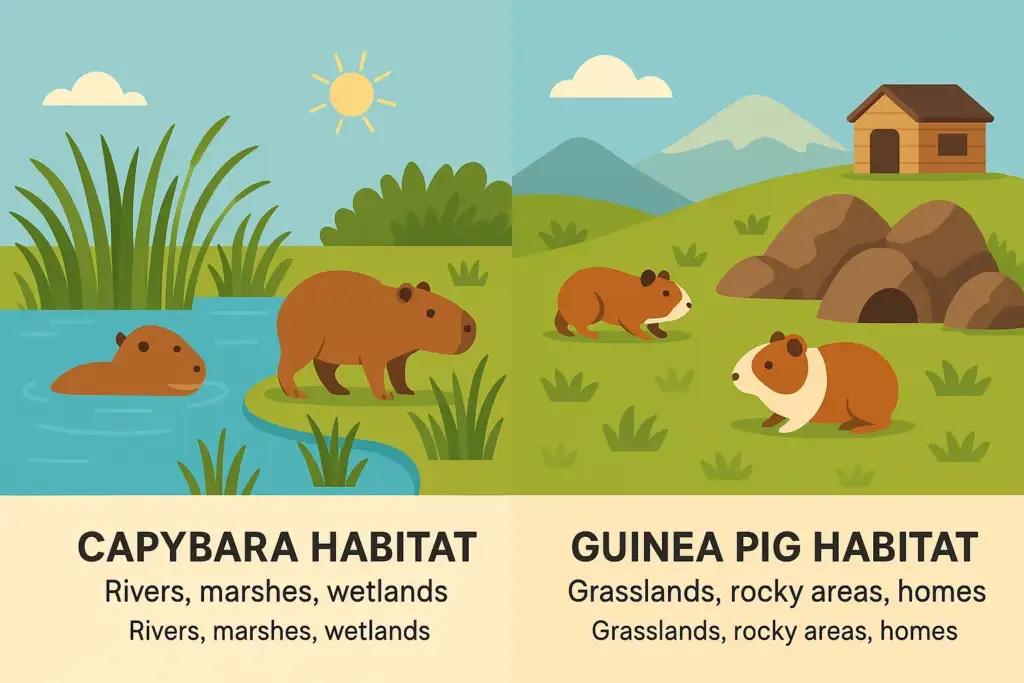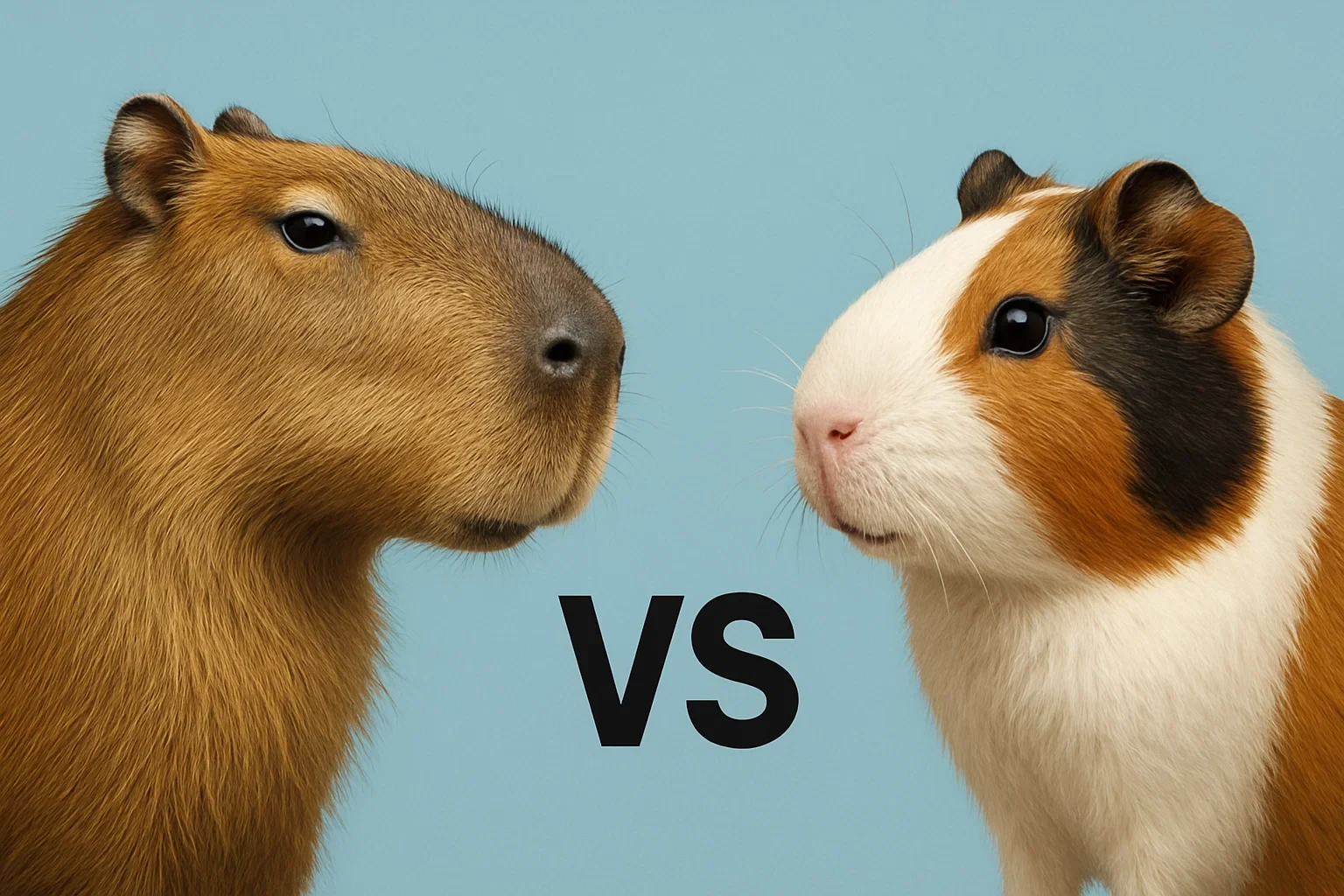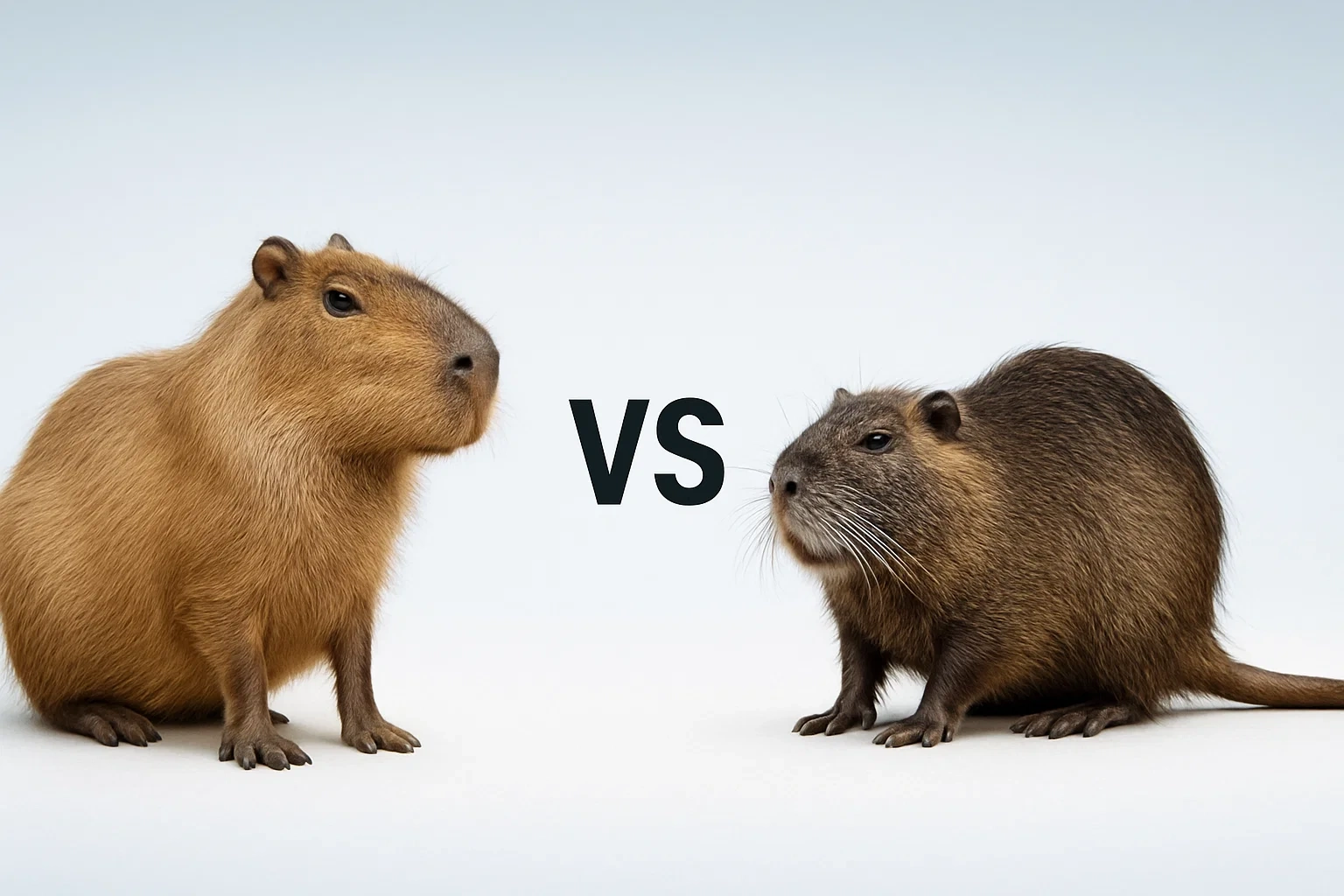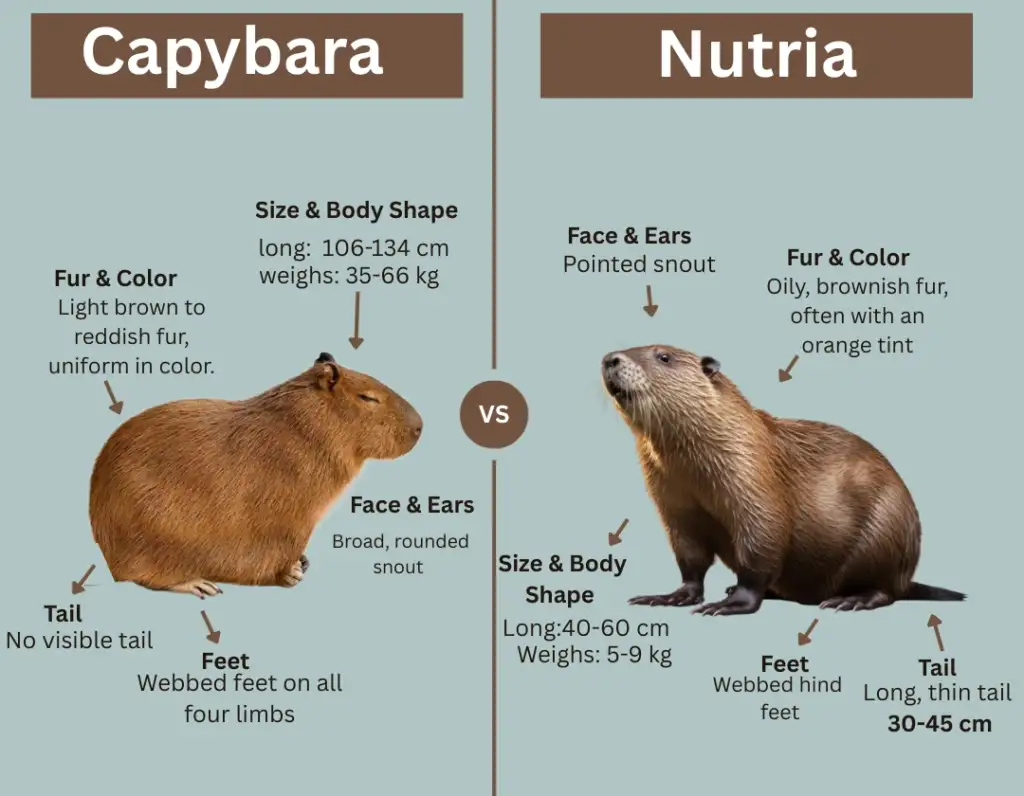Yes–believe it or not, capybaras and guinea pigs are distant cousins. Both are rodents in the cavy family (Caviidae). You might even hear capybaras referred to as “giant guinea pigs.” They indeed share a family tree, but beyond that, in terms of kinship, they’re very different creatures. Capybaras are giant semi-aquatic rodents (think of a Labrador-sized pet), while guinea pigs are small, land-loving pets (about the size of a basketball). From the start, capybaras can top 4 ft in length and 100+ lbs, whereas guinea pigs are only about 8–16 inches long and weigh around 1–3 lbs. Both eat plants and like company, but that’s pretty much where the similarities end. Let’s dive into a friendly, detailed comparison and clear up any confusion just like chatting with a friend over coffee (perhaps a carrot juice for your little cavy buddy!).
Family Tree and Origins
Capybaras (Hydrochoerus hydrochaeris) and guinea pigs (Cavia porcellus) truly share ancestry – they both belong to the rodent family Caviidae. In fact, capybaras are in the subfamily Hydrochoerinae and guinea pigs in Caviinae, making them “second cousins” among cavies. Both originally hail from South America: capybaras roam savannas and wetlands from Panama down through Brazil and Argentina, while guinea pigs come from the Andes mountains of the Inca region (wild cavies still live in South American grasslands).
- Cavy Family (Caviidae): Both animals are cavies, so they look somewhat alike at a glance (stocky body, blunt nose). But a capybara is a chubby hippo-like giant, whereas a guinea pig is a tiny, chubby pebble.
| Characteristic | Capybara | Guinea Pig |
| Kingdom | Animalia | Animalia |
| Class | Mammalia | Mammalia |
| Order | Rodentia | Rodentia |
| Family | Caviidae | Caviidae |
| Subfamily | Hydrochoerinae | Caviinae |
| Length/Size | 39–51 inches (100–130 cm) | 8–10 inches (20–25 cm) |
| Weight | 77–150 pounds (35–68 kg) | 1.5–2.5 pounds (0.7–1.1 kg) |
| Habitat | Wetlands, rivers, marshes | Grasslands, rocky areas (in the wild); domestic for pets |
| Social Structure | Large groups (10–20+ individuals) | Smaller groups or pairs |
| Lifespan | Approximately 8–10 years (wild) | Approximately 4–8 years (domestic) |
| Swimming Ability | Excellent; highly adapted for aquatic life | Limited; primarily terrestrial |
| Communication | Barks, whistles, purrs | High-pitched squeaks, soft purrs, rumbling sounds |
- Domestication: Guinea pigs were domesticated by Andean people over 3,000 years ago and today exist only as pets or livestock (there are no wild “domestic” guinea pigs left). Capybaras, on the other hand, remain wild animals. (They are farmed for meat/hides in South America, but they weren’t selectively bred like guinea pigs have been.) This means guinea pigs are used to living with humans, while capybaras, though gentle, are naturally wild.
Size and Appearance
Here’s the biggest shock: capybaras are huge compared to guinea pigs. Picture a chubby dachshund vs. a teacup hamster–that’s the difference in rodent terms.
Length & Weight
I vividly recall the first time I saw a capybara at a wildlife sanctuary. Its sheer size was astonishing. An adult capybara can be about 0.9–1.3 m long (3–4.3 ft) and weigh anywhere from 77 to 146 pounds. The average guinea pig is just 20–40 cm long (8–16 in) and weighs 0.5–1.5 kg (1–3 lbs). In other words, you could fit several guinea pigs on top of one capybara!

Build:
Capybaras have a barrel-shaped body, with a big, round belly and sturdy legs, kind of like a pig without a tail. They have slightly webbed toes to help them swim. Guinea pigs are much smaller and rounder, with short legs and no webbing. They look a bit like chubby hamsters with no tail. Both species have blunt, squarish faces, small ears, and big dark eyes, but a capybara’s head is proportionally much larger and longer.
Coat & Colours:
Capybara fur is coarse and brownish, letting water slide off easily. Guinea pigs come in many coat colours and textures (short, long, fuzzy, smooth) from white to brown to black patterns.
Habitat & Lifestyle
Capybaras are true water lovers. They live near rivers, marshes, flooded grasslands, and wet forests in warm climates. They have “aquatic” in their name (Hydrochoerus means “water pig”) for a reason. They spend much of the day grazing on banks or even swimming, often escaping predators by diving into rivers. Capybaras’ eyes, ears, and nostrils sit high on their heads so they can keep most of their body underwater – just like a hippo!

Guinea pigs, in contrast, originally came from drier highlands and plains. Wild cavies inhabit grasslands and rocky areas in the Andes and nearby regions (Brazil, Colombia, etc.). Domestic guinea pigs have adapted to indoor life as pets. They live in human homes or hutches, not in water at all. While both are crepuscular (active around dawn and dusk), capybaras often cool off in water during hot afternoons, whereas guinea pigs scamper among grass and hide in tunnels or under shelters when it’s too hot or they’re scared.
Social Groups:
Both are social, but capybaras live in much larger groups. Wild capybara “herds” can be 10–20 individuals on average, and sometimes up to 100. A typical wild group includes a dominant male, several females, subordinate males, and their young. By contrast, wild guinea pigs form smaller family groups – usually one male (boar), a few females (sows), and their pups. In captivity, guinea pigs are happiest in pairs or small groups of the same species. (Fun fact: both species even establish dominance hierarchies – capybaras with gentle nudges, and cavies by grooming and squeaking at each other.)
Diet & Nutrition
Both capybaras and guinea pigs are strict herbivores. They mainly eat grasses and vegetation.
Capybara Diet:
They graze like cows, nibbling on grasses, aquatic plants, and even tree bark. They have ever-growing teeth that get worn down by these fibrous plants. Unusually, capybaras also practice coprophagy: they eat some of their own soft faeces to absorb extra nutrients from their plant diet. This double-digesting helps them get every bit of goodness from tough grasses.
Guinea Pig Diet:
Guinea pigs in the wild ate meadow grasses and herbs. Pet guinea pigs typically get hay, grass pellets, and fresh veggies or fruits as treats. One important note: guinea pigs cannot synthesise vitamin C, so their diet must include a source (like bell peppers or citrus fruits) to prevent scurvy, much like humans. (Capybaras, being wild herbivores, get all the needed nutrients from their natural forage.)
Despite this similarity, remember the scale. Capybaras require large fields of grass and water plants to eat, while a household hay bale feeds a guinea pig easily. Both chew a lot, have continuously growing teeth, and need constant access to fibrous food to stay healthy.
Temperament & Personality
Think of capybaras as the “gentle giants” of the rodent world, and guinea pigs as affectionate little characters. Both can be quite friendly, but their personalities play out on very different stages.
Capybaras are famously calm, docile, and friendly. People often call them “nature’s therapy animals” because they’re so laid-back. In the wild or zoos, you’ll see capybaras lounging together, even letting birds or small monkeys hang out on their backs. They have a soothing purr and rarely show aggression. I remember watching capybaras in a wildlife video, cuddling up together like a family – one was literally grooming another’s fur. This easygoing nature makes them popular in animal sanctuaries. If you’re lucky to meet one (with enough space!), it might gently sniff you or even tolerate a slow pet.
Guinea pigs are curious, playful, and affectionate in their own way. They will happily nibble veggies from your hand and chirp or “wheek” at you when they’re excited. Each piggy has a distinct personality – some are bold and will zip around exploring, others are shy and need more time to trust. Unlike capybaras, guinea pigs will freeze or hide at first when scared. But once they warm up, they love attention: many bond closely with their owners (I have a friend whose piggy jumped into her lap as a “thank you” for a treat!). In short, capybaras are more laid-back overall, while guinea pigs can be more skittish or energetic but equally loving with gentle handling.
Behaviour & Social Life
Both species are social, but their “social skills” show differently:
Group Living:
As mentioned, capybaras live in big family groups, sometimes with multiple males, so they spend their days grooming each other, playing in water together, and coordinating as a herd. Guinea pigs live in smaller families; a cavy huddle might simply be one boar with a few sows. You’ll often see them squealing at each other when happy or communicating softly. Both species groom themselves and each other – snuggling side-by-side or sitting on a lap in the case of a beloved guinea pig pet.
Activity Patterns:
Capybaras are crepuscular/diurnal – most active at dawn or dusk, cooling off in water during midday heat. Guinea pigs also prefer dawn and dusk; they’ll quietly munch hay in the early morning and evening, often snoozing in shade midday. Neither is truly nocturnal.
Communication:
Capybaras have a range of sounds – they bark, whine, purr, and whistle to call each other. You might hear a yelp if one is surprised, or a purring rumble when a pair nuzzles. Guinea pigs communicate with high-pitched squeaks (wheeks), purrs, and chirps. A squeaky “wheek!” might mean “food, please!” while happy purring can indicate contentment. Both species are surprisingly expressive once you know their language.
Defence:
When threatened, capybaras typically flee to water or huddle in their group for safety. Their best escape is diving into a river and swimming away. Guinea pigs will freeze (playing dead) or dash for a hiding spot. Neither is aggressive; they’re prey animals, so hiding is their default.
Intelligence & Abilities
Surprisingly, both capybaras and guinea pigs are smart in their ways.
Capybaras rank among the brightest rodents. They can be trained almost like a dog – learning routines, coming when called, even playing simple fetch. Researchers and zookeepers note that capybaras solve problems (like figuring out the best path through water to reach a tasty plant). People who keep capybaras as pets (yes, it happens in some places!) often say they’re trainable and remember cues. In fact, a study author compared their smarts to dogs.
Guinea pigs also have plenty of smarts. They recognise their owners by voice, can learn their name (many do respond when called), and remember the route to their food bowl or hiding tunnel. They won’t perform tricks like a capy might, but they learn routines and navigate mazes quite well. For example, a pet guinea pig often “pops” (hops excitedly) when it sees its owner or a favourite snack – a learned behaviour from experience!
Swimming:
Capybaras are born swimmers – their partly webbed feet make them excellent in water. They’ll even fall asleep floating on their backs. In short, water is an escape and playground for capys. Guinea pigs, in contrast, are not adapted to water. They can paddle in a pinch, but it’s stressful. (Don’t worry – you rarely need to bathe a guinea pig, and most avoid even shallow water pools.)
Running:
Despite their bulk, capybaras can sprint fast (up to ~35 km/h or 22 mph) for short bursts to escape predators on land. Guinea pigs can scurry pretty quickly, too – roughly 5 km/h (3 mph). They use that burst of speed and small size to dash into tunnels or underbrush. (I often laugh seeing how a startled piggy “zooms” under its blanket faster than you’d expect.)
Living with Humans (Domestication and Pets)
Guinea pigs and capybaras have very different relationships with people.
Guinea Pigs Domestication:
These little fellows are among the longest-domesticated rodents. In the Andes, they were bred for meat and companionship thousands of years ago. Today, they’re a classic pet worldwide. Breed associations, pet shops, and cavy clubs abound in many countries. Guinea pigs are designed by evolution (and by breeders) to live alongside humans: they generally thrive in hutches or homes, don’t bite, and enjoy handling. Their care is well-understood: they need a cozy cage, hay, veggies, and gentle attention. Lifespan in captivity is about 4–8 years, often longer with a good diet.
Capybaras Domestication:
These guys are still wild at heart. Very few people have them as pets (and it requires a lot of space, special permits, and a pond!). Capybaras are sometimes raised on farms in South America for their meat and hides, but they weren’t truly domesticated breed-by-breed. When kept in captivity (zoos, sanctuaries, or some private owners), they need an outdoor enclosure with lots of room, a pool of water, and social company (they get lonely alone). They can bond with caretakers over time thanks to their gentle nature, but they’re not cuddly lap pets. Capybaras live about 8–10 years, and require veterinary care similar to a farm animal.
| Care Aspect | Capybara | Guinea Pig |
| Housing | Large outdoor enclosure with water features | Spacious cage or play area with tunnels and hides |
| Diet | High-fibre grasses, aquatic plants, and natural vegetation | Timothy hay, fresh vegetables, limited fruits, vitamin C‑supplemented |
| Exercise | Regular roaming and swimming; social play in groups | Daily out‑of‑cage time, interactive toys, and tunnels |
| Grooming | Self‑grooming with emphasis on clean water and enclosure | Self‑grooming, regular cage cleaning, and occasional brushing |
| Social Needs | Best kept in groups to mimic natural herd behaviour | Thrive in pairs or small groups; may need extra attention if solo |
| Veterinary Care | Periodic check‑ups with exotic animal specialists | Routine check‑ups with a small animal veterinarian |
In short, guinea pigs are human-friendly small pets; capybaras are human-friendly big wild animals that require a farm-like setup. One is practical for a family home, the other is a specialised exotic adoption.
Pet Ownership Experiences: Stories from the Field
No blog about animals would be complete without some real-life anecdotes. Over the years, I’ve come to know many pet owners who have had transformative experiences with their capybaras and guinea pigs. Their stories not only provide practical insights but also warm the heart.
A Capybara Owner’s Tale
I recall meeting a capybara owner who described her animal as “a gentle giant that changed my perspective on life.” She recounted how her capybara, rescued from a shelter, quickly became the centrepiece of her sprawling backyard water garden. Every morning, as the sun crests the horizon, the capybara can be seen gracefully sliding into the water for a refreshing dip. Its calm demeanour, combined with a touch of playful mischief (like allowing local birds to perch on its back), created a daily ritual of joy and mindfulness. For her, tending to this capybara isn’t merely pet care—it’s a form of meditation, a slow, measured way of connecting with nature.
A Guinea Pig Enthusiast’s Journey
On the flip side, I’ve met families who swear by the joys of having guinea pigs. One mom told me how her children learned responsibility and empathy by taking turns feeding their pair of guinea pigs, each with its own little personality. Whether it was the morning chorus of soft squeaks or the tender grooming sessions that would spread warmth around the household, these guinea pigs became cherished members of the family. Their small size didn’t limit the huge joy and life lessons they imparted. The story of that family is a perfect example of how even the tiniest pet can have a grand impact on our lives.
These personal experiences underscore the fact that while science and data are essential, the emotional connections we form with our pets are what truly enrich our lives.
Quick Comparison Table
| Feature | Capybara | Guinea Pig |
| Scientific Name | Hydrochoerus hydrochaeris (common capybara) | Cavia porcellus (domestic guinea pig) |
| Family (Caviidae) | Yes (subfamily Hydrochoerinae) | Yes (subfamily Caviinae) |
| Size (length) | ~0.9–1.3 m (3–4.3 ft) | ~20–40 cm (8–16 in) |
| Weight | 35–66 kg (77–146 lbs) | 0.5–1.5 kg (1–3 lbs) |
| Lifespan (in captivity) | 8–10 years | 4–8 years |
| Habitat | Semi-aquatic: marshes, rivers, flooded savannas (S/C America) | Grasslands and shrublands of the Andes (original); now domestic pet habitat worldwide |
| Activity | Daytime/Crepuscular (dawn/dusk); excellent swimmers | Crepuscular (dawn/dusk); generally avoid water |
| Social Structure | Very social; herds of 10–20 (sometimes 100) | Social; smaller groups (typically 1 male + 2–5 females) |
| Temperament | Calm and friendly; docile “gentle giant” | Curious and sweet; can be timid/skittish but usually gentle |
| Diet | Herbivore – grasses and aquatic plants | Herbivore – hay, grass, veggies (needs dietary vitamin C) |
| Swimming | Excellent swimmer (webbed feet); often submerges for safety | Can paddle briefly if needed, but strongly dislikes water |
| Domestication | Wild (never fully domesticated; sometimes farmed/petted) | Fully domesticated (no wild domestic form; ancestor wild cavies) |
This table highlights the biggest similarities (both are cavy rodents and herbivores) and stark contrasts (size, habitat, and pet-dom).
Fun Facts & Final Thoughts
Both animals are surprisingly charming in their own ways:
- “Nature’s bathtub buddies”: In the wild, capybaras often share their ponds with other creatures. You might see turtles on a capy’s back, or birds riding around on them as the capy swims. It’s almost like their own floating taxi service!
- Capybara nicknames: Besides “giant guinea pig,” people sometimes call capybaras the “world’s largest guinea pig,” the “water pig,” or “river pig” (due to their hog-like snout). But remember – they’re rodents, not pigs.
- Guinea pig squeals: Guinea pigs make a loud “wheek!” when they’re hungry or excited. If you own one, you’ll recognise that welcome sound when you walk by their cage. They also “purr” when happy – like a tiny content cat.
- Temperature seekers: Both species dislike cold weather. A capy without water or mud wallows can overheat, and a cold, wet capybara won’t last long. Guinea pigs, originally mountain rodents, can get chilly easily and may huddle for warmth – so most owners put a fleece blanket or igloo in the cage.
- Speed differences: Despite appearances, a capybara can outrun some humans for short bursts. But a startled guinea pig can still zip into its hidey-hole faster than you can blink!
In summary, capybaras and guinea pigs share a family and herbivorous lifestyle, but that’s where the overlap ends. Capybaras are the gentle giants of the rodent world – semi-aquatic, social, and massive – while guinea pigs are the tiny charmers who have been our companions for millennia. As a friend, comparing them might compare them: capybaras are like a friendly dog in a pond, and guinea pigs are like playful kittens in a field. Both are delightful, but you wouldn’t swap one for the other in your lap!
Sources: Authoritative zoological and pet-care references were used to compile this guide, along with insights from capybara and guinea pig experts. All facts are confirmed by credible sources to give you the full picture of capybaras vs guinea pigs. Enjoy your learning and maybe give your furry friends an extra carrot!
For general animal facts and classification:
- Wikipedia: https://en.wikipedia.org/wiki/Capybara
- Britannica: https://www.britannica.com/animal/capybara-genus
For pet care and domestication:
- The Spruce Pets: https://www.thesprucepets.com/capybara-pet-4101211
- Purdue University: https://vet.purdue.edu/hospital/small-animal/primary-care/documents/CareofGuineaPigs.pdf
- Smithsonian’s National Zoo: https://nationalzoo.si.edu/animals/guinea-pig



